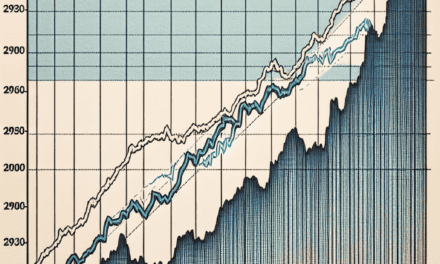“U.S. ETF Count Hits 4,000: A New Era of Investment Opportunities Unleashed!”
Introduction
The U.S. exchange-traded fund (ETF) market has reached a significant milestone, surpassing 4,000 listed ETFs as of 2023. This remarkable growth reflects a surge in new offerings, driven by increasing investor demand for diverse investment options and innovative financial products. The expansion of the ETF landscape highlights the evolving preferences of investors seeking flexibility, cost efficiency, and access to a wide array of asset classes. As financial institutions continue to launch new ETFs, the market is poised for further evolution, catering to a growing appetite for tailored investment solutions.
U.S. ETF Market Milestone: 4,000 Funds and Counting
The U.S. exchange-traded fund (ETF) market has reached a significant milestone, surpassing 4,000 funds, a testament to the growing popularity and diversification of investment options available to investors. This remarkable achievement reflects not only the increasing acceptance of ETFs as a viable investment vehicle but also the dynamic nature of the financial markets, which continue to evolve in response to investor demand and market trends. As the number of ETFs expands, so too does the variety of strategies and asset classes they encompass, catering to a wide range of investment preferences and risk tolerances.
The surge in new ETF offerings can be attributed to several factors. First and foremost, the low-cost structure of ETFs has made them an attractive alternative to traditional mutual funds. Investors are increasingly drawn to the transparency and liquidity that ETFs provide, allowing them to buy and sell shares throughout the trading day at market prices. This flexibility is particularly appealing in a fast-paced market environment where timely decision-making can significantly impact investment outcomes. Furthermore, the rise of passive investing strategies has contributed to the proliferation of ETFs, as many investors seek to replicate the performance of specific indices rather than actively manage their portfolios.
In addition to traditional equity and bond ETFs, the market has witnessed a notable increase in thematic and niche offerings. These specialized funds focus on specific sectors, trends, or investment themes, such as technology, renewable energy, or emerging markets. This diversification allows investors to tailor their portfolios to align with their individual beliefs and investment goals. Moreover, the introduction of actively managed ETFs has further broadened the landscape, providing investors with the potential for enhanced returns through professional management while still enjoying the benefits of ETF structure.
As the ETF market continues to grow, regulatory developments also play a crucial role in shaping its trajectory. The U.S. Securities and Exchange Commission (SEC) has been actively working to streamline the approval process for new ETFs, which has facilitated the rapid launch of innovative products. This regulatory support has encouraged asset managers to explore new strategies and asset classes, resulting in a more vibrant and competitive marketplace. Additionally, the increasing participation of institutional investors in the ETF space has further legitimized these products, driving demand and fostering innovation.
While the growth of the ETF market presents numerous opportunities, it also raises important considerations for investors. As the number of funds increases, so does the complexity of the landscape, making it essential for investors to conduct thorough research before selecting an ETF. Understanding the underlying assets, expense ratios, and performance history of a fund is critical to making informed investment decisions. Furthermore, as with any investment, it is vital to consider one’s risk tolerance and investment horizon when incorporating ETFs into a portfolio.
In conclusion, the U.S. ETF market’s milestone of reaching 4,000 funds underscores the ongoing evolution of investment strategies and the increasing demand for diverse financial products. As investors continue to seek cost-effective and flexible investment options, the ETF landscape is likely to expand further, offering even more choices for those looking to navigate the complexities of the financial markets. With regulatory support and a growing array of innovative offerings, the future of the ETF market appears bright, promising continued growth and opportunities for investors.
The Surge in New ETF Offerings: What It Means for Investors
The recent milestone of the U.S. exchange-traded fund (ETF) count reaching 4,000 is a significant development in the financial landscape, reflecting a robust surge in new offerings. This increase in the number of ETFs is not merely a quantitative change; it represents a qualitative shift in how investors can access various asset classes, sectors, and investment strategies. As the market continues to evolve, understanding the implications of this surge is crucial for both seasoned and novice investors.
One of the primary drivers behind the proliferation of ETFs is the growing demand for diversified investment options. Investors are increasingly seeking ways to gain exposure to specific sectors, themes, or geographic regions without the need to purchase individual stocks or bonds. This trend has led to the introduction of niche ETFs that focus on everything from renewable energy to artificial intelligence, allowing investors to align their portfolios with their personal values and investment goals. Consequently, the expansion of ETF offerings provides a broader array of choices, catering to diverse investment strategies and risk appetites.
Moreover, the competitive landscape among ETF providers has intensified, resulting in lower fees and improved product offerings. As more firms enter the market, they are compelled to differentiate themselves through innovative strategies and cost-effective solutions. This competition benefits investors, as it drives down expense ratios and enhances the overall value proposition of ETFs. Lower costs can significantly impact long-term investment returns, making it increasingly attractive for investors to consider ETFs as a viable option for portfolio construction.
In addition to cost efficiency, the surge in new ETF offerings has also led to increased transparency and liquidity in the market. ETFs are inherently designed to be traded on exchanges, providing investors with the ability to buy and sell shares throughout the trading day. This liquidity is particularly advantageous during periods of market volatility, as it allows investors to react swiftly to changing market conditions. Furthermore, the transparency associated with ETFs, including daily disclosures of holdings and pricing, empowers investors to make informed decisions based on real-time data.
As the ETF market continues to expand, it is essential for investors to remain vigilant and conduct thorough research before making investment decisions. While the variety of options can be appealing, not all ETFs are created equal. Investors should consider factors such as the underlying index, the fund’s performance history, and the issuer’s reputation. Additionally, understanding the tax implications and potential risks associated with specific ETFs is crucial for effective portfolio management.
The surge in new ETF offerings also raises questions about market saturation and the potential for overcrowding in certain segments. As more products enter the market, there is a risk that some may struggle to attract sufficient assets, leading to lower trading volumes and potential liquidity issues. Therefore, investors must exercise discernment when selecting ETFs, focusing on those with a solid investment thesis and a clear path to growth.
In conclusion, the milestone of 4,000 ETFs in the U.S. signifies a dynamic and evolving investment landscape. The surge in new offerings presents both opportunities and challenges for investors. By embracing the diversity of choices available while remaining cautious and informed, investors can effectively navigate this expanding market and harness the potential benefits that ETFs offer. As the financial world continues to innovate, staying abreast of these developments will be key to making sound investment decisions.
Analyzing the Growth of ETFs: Trends and Predictions
The recent milestone of the U.S. exchange-traded fund (ETF) count reaching 4,000 is a significant indicator of the growing popularity and acceptance of these investment vehicles. This surge in the number of ETFs can be attributed to various trends that have emerged in the financial markets, reflecting a broader shift in investor preferences and behaviors. As we analyze the growth of ETFs, it becomes evident that several key factors are driving this expansion, and understanding these trends can provide valuable insights into the future of the ETF landscape.
One of the most notable trends contributing to the proliferation of ETFs is the increasing demand for low-cost investment options. Investors are becoming more cost-conscious, seeking ways to minimize fees while maximizing returns. ETFs typically offer lower expense ratios compared to traditional mutual funds, making them an attractive choice for both retail and institutional investors. This cost efficiency is particularly appealing in an environment where every basis point can significantly impact overall performance. As a result, asset managers are responding to this demand by launching new ETFs that cater to various investment strategies and asset classes.
Moreover, the rise of passive investing has played a crucial role in the growth of ETFs. Many investors are shifting away from actively managed funds in favor of passive strategies that aim to replicate the performance of specific indices. This trend has been bolstered by research indicating that, over the long term, passive funds often outperform their actively managed counterparts. Consequently, the ETF structure, which inherently supports passive investment strategies, has gained traction. As more investors recognize the benefits of passive investing, the number of ETFs designed to track various indices continues to expand, further contributing to the overall growth of the market.
In addition to cost efficiency and passive investing, the increasing sophistication of investors is also driving the demand for specialized ETFs. As investors seek to diversify their portfolios and gain exposure to niche markets, asset managers are responding by creating ETFs that focus on specific sectors, themes, or investment strategies. For instance, thematic ETFs that target emerging trends such as clean energy, technology innovation, or demographic shifts have gained popularity. This trend towards specialization not only caters to the evolving preferences of investors but also enhances the overall appeal of ETFs as versatile investment tools.
Furthermore, technological advancements have facilitated the growth of ETFs by streamlining the process of creating and managing these funds. The rise of digital platforms and robo-advisors has made it easier for investors to access a wide range of ETFs, allowing for greater flexibility and convenience in portfolio management. As technology continues to evolve, it is likely that we will see further innovations in the ETF space, including the introduction of new products and features that enhance the investor experience.
Looking ahead, the future of ETFs appears promising, with several predictions suggesting continued growth in the coming years. As more investors become aware of the benefits of ETFs, including their liquidity, transparency, and tax efficiency, it is reasonable to expect that the number of offerings will continue to rise. Additionally, as regulatory frameworks evolve and new market opportunities emerge, asset managers will likely introduce innovative products that cater to the changing needs of investors.
In conclusion, the growth of ETFs to 4,000 offerings is a testament to the evolving landscape of investment strategies and investor preferences. With trends such as cost efficiency, passive investing, specialization, and technological advancements driving this expansion, the ETF market is poised for further growth. As we move forward, it will be essential for investors to stay informed about these trends and consider how they can leverage the diverse array of ETFs available to enhance their investment portfolios.
The Impact of 4,000 ETFs on Investment Strategies
The recent milestone of 4,000 exchange-traded funds (ETFs) in the United States marks a significant evolution in the investment landscape, reflecting both the growing popularity of these financial instruments and the increasing sophistication of investors. As the number of ETFs continues to rise, it is essential to consider the implications this growth has on investment strategies. The proliferation of ETFs offers investors a diverse array of options, enabling them to tailor their portfolios to meet specific financial goals and risk tolerances.
One of the most notable impacts of reaching 4,000 ETFs is the enhanced accessibility to various asset classes and investment themes. Investors can now easily gain exposure to niche markets, sectors, and strategies that were previously difficult to access. For instance, thematic ETFs focusing on emerging technologies, such as artificial intelligence or renewable energy, allow investors to capitalize on trends that align with their beliefs and values. This increased accessibility not only democratizes investment opportunities but also encourages a more informed and engaged investor base.
Moreover, the sheer volume of ETFs fosters greater competition among fund providers, which can lead to lower expense ratios and improved product offerings. As more players enter the market, they are incentivized to innovate and differentiate their products. This competition can result in the introduction of more specialized ETFs, such as those that employ unique investment strategies or focus on specific geographic regions. Consequently, investors benefit from a wider selection of low-cost options, which can enhance overall portfolio performance.
In addition to cost advantages, the growth in the number of ETFs also influences asset allocation strategies. With a broader range of investment vehicles available, investors can more effectively diversify their portfolios. Diversification is a fundamental principle of investing, as it helps to mitigate risk by spreading exposure across various asset classes. The availability of ETFs that track different indices, sectors, or commodities allows investors to construct well-rounded portfolios that align with their risk tolerance and investment objectives. This flexibility is particularly valuable in volatile market conditions, where having a diversified portfolio can help cushion against significant losses.
Furthermore, the rise of ETFs has transformed the way investors approach active versus passive management. Traditionally, active management involved selecting individual securities in an attempt to outperform the market. However, with the increasing popularity of passive ETFs that track broad market indices, many investors are now gravitating towards a more passive investment approach. This shift has prompted a reevaluation of investment strategies, as investors weigh the benefits of lower fees and consistent performance against the potential for higher returns associated with active management.
As the ETF market continues to expand, it is also essential to consider the implications for market liquidity and price discovery. The growing number of ETFs can enhance market efficiency by providing additional trading venues and increasing the volume of transactions. This heightened liquidity can lead to tighter bid-ask spreads, making it easier for investors to enter and exit positions. However, it is crucial for investors to remain vigilant, as the rapid growth of ETFs may also introduce complexities related to market dynamics and the potential for mispricing.
In conclusion, the achievement of 4,000 ETFs in the United States signifies a transformative moment in the investment landscape. This milestone not only enhances accessibility and diversification but also reshapes investment strategies and market dynamics. As investors navigate this evolving environment, they must remain informed and adaptable, leveraging the opportunities presented by the expanding ETF universe to achieve their financial goals.
Key Players in the U.S. ETF Market: Who’s Leading the Charge?
As the U.S. exchange-traded fund (ETF) market continues to expand, reaching a remarkable milestone of 4,000 ETFs, it is essential to examine the key players driving this growth. The surge in new offerings has not only diversified the investment landscape but has also intensified competition among various financial institutions. Prominent asset management firms have emerged as leaders in this dynamic environment, each contributing to the proliferation of innovative products designed to meet the evolving needs of investors.
BlackRock, the world’s largest asset manager, stands at the forefront of the U.S. ETF market. With its iShares brand, BlackRock has consistently introduced a wide array of ETFs that cater to different investment strategies and asset classes. The firm’s commitment to providing low-cost, transparent investment options has resonated with both institutional and retail investors alike. As a result, BlackRock has amassed a significant share of the market, solidifying its position as a dominant force in the ETF space. This leadership is further bolstered by the firm’s extensive research capabilities and global reach, allowing it to respond swiftly to market trends and investor demands.
In addition to BlackRock, Vanguard has also played a pivotal role in shaping the ETF landscape. Known for its investor-centric approach and emphasis on low fees, Vanguard has successfully attracted a loyal customer base. The firm’s focus on index-based investing has not only democratized access to diversified portfolios but has also encouraged other asset managers to adopt similar strategies. Vanguard’s commitment to transparency and its advocacy for investor rights have further enhanced its reputation, making it a key player in the ongoing evolution of the ETF market.
State Street Global Advisors, another major contender, has made significant contributions to the growth of ETFs through its SPDR brand. The introduction of the SPDR S&P 500 ETF Trust in 1993 marked a turning point in the investment landscape, as it was one of the first ETFs available to investors. Since then, State Street has expanded its offerings to include a diverse range of sector-specific and thematic ETFs, catering to the growing demand for targeted investment strategies. The firm’s innovative approach and ability to adapt to changing market conditions have positioned it as a formidable player in the competitive ETF arena.
Moreover, newer entrants have begun to carve out their niches within the market, challenging established players with unique offerings. Firms such as ARK Invest have gained attention for their focus on disruptive innovation and thematic investing. By targeting specific trends, such as technology and sustainability, ARK has attracted a dedicated following of investors seeking exposure to high-growth sectors. This trend highlights a broader shift in investor preferences, as many are increasingly looking for ETFs that align with their values and investment goals.
As the U.S. ETF market continues to evolve, the competition among these key players is likely to intensify. The ongoing innovation in product offerings, coupled with the increasing demand for low-cost investment solutions, will drive further growth in the sector. Additionally, regulatory changes and advancements in technology may open new avenues for ETF development, allowing firms to create even more tailored products for investors. In this rapidly changing landscape, the ability to adapt and respond to market dynamics will be crucial for maintaining a competitive edge. Ultimately, the interplay between established giants and emerging challengers will shape the future of the U.S. ETF market, ensuring that it remains a vital component of the investment ecosystem.
Understanding the Benefits of Investing in ETFs
The recent milestone of the U.S. exchange-traded fund (ETF) count reaching 4,000 is a testament to the growing popularity of these investment vehicles among both individual and institutional investors. As the landscape of investment options continues to evolve, understanding the benefits of investing in ETFs becomes increasingly important. One of the primary advantages of ETFs is their inherent flexibility. Unlike traditional mutual funds, which are bought and sold at the end of the trading day, ETFs trade on stock exchanges throughout the day, allowing investors to react swiftly to market changes. This intraday trading capability provides a level of liquidity that is particularly appealing in volatile markets.
Moreover, ETFs typically have lower expense ratios compared to mutual funds. This cost efficiency is largely due to their passive management style, as many ETFs aim to replicate the performance of a specific index rather than actively selecting securities. Consequently, investors can benefit from broad market exposure without incurring high management fees. This aspect is especially significant for long-term investors, as lower costs can lead to substantial savings over time, ultimately enhancing overall returns.
In addition to cost efficiency, diversification is another compelling reason to consider ETFs. By investing in a single ETF, investors can gain exposure to a wide array of securities across various sectors and asset classes. This diversification helps mitigate risk, as the performance of a single security has a diminished impact on the overall portfolio. For instance, an investor who purchases an ETF that tracks the S&P 500 is effectively investing in 500 different companies, thereby spreading risk and reducing the potential for significant losses.
Furthermore, the tax efficiency of ETFs is a noteworthy benefit that distinguishes them from other investment vehicles. ETFs are structured in a way that allows investors to minimize capital gains distributions, which can be a significant tax burden for mutual fund investors. This tax efficiency arises from the unique creation and redemption process of ETFs, which allows investors to buy and sell shares without triggering taxable events. As a result, investors can maintain more of their returns, further enhancing the appeal of ETFs as a long-term investment option.
Another advantage of ETFs is their accessibility. With the rise of online brokerage platforms, investors can easily buy and sell ETFs with minimal barriers to entry. This accessibility democratizes investing, allowing individuals with varying levels of capital to participate in the market. Additionally, the wide range of ETFs available caters to diverse investment strategies and preferences, from those seeking exposure to specific sectors or themes to those looking for international diversification.
As the ETF market continues to expand, it is essential for investors to remain informed about the various options available. The increasing number of offerings provides opportunities to tailor investment strategies to individual goals and risk tolerances. However, it is crucial to conduct thorough research and understand the underlying assets and strategies of each ETF before making investment decisions.
In conclusion, the surge in new ETF offerings and the milestone of reaching 4,000 ETFs in the U.S. reflect a broader trend towards more accessible, cost-effective, and diversified investment options. By understanding the benefits of investing in ETFs, investors can make informed decisions that align with their financial objectives, ultimately enhancing their investment experience in an ever-evolving market landscape.
Future of ETFs: What Lies Ahead After Reaching 4,000?
The recent milestone of the U.S. exchange-traded fund (ETF) count reaching 4,000 is a significant indicator of the growing popularity and acceptance of these investment vehicles. As the market continues to expand, it raises important questions about the future of ETFs and what lies ahead for investors and issuers alike. The proliferation of new offerings suggests a robust appetite for diverse investment strategies, but it also necessitates a closer examination of the implications for market dynamics, regulatory frameworks, and investor behavior.
One of the most notable trends in the ETF landscape is the increasing variety of products available to investors. From traditional equity and bond ETFs to more niche offerings such as thematic, sector-specific, and actively managed funds, the options are becoming more sophisticated. This diversification allows investors to tailor their portfolios to meet specific goals and risk tolerances. As a result, the future of ETFs may see an even greater emphasis on customization, with issuers likely to develop more innovative products that cater to evolving market demands.
Moreover, the rise of technology and data analytics is poised to play a crucial role in shaping the future of ETFs. With advancements in artificial intelligence and machine learning, fund managers can analyze vast amounts of data to identify trends and optimize portfolio performance. This technological integration not only enhances the efficiency of ETF management but also empowers investors with more informed decision-making tools. As these technologies continue to evolve, they may lead to the creation of ETFs that are more responsive to market changes, thereby increasing their appeal to a broader range of investors.
In addition to technological advancements, regulatory considerations will also influence the future trajectory of ETFs. As the market grows, regulators are likely to scrutinize new products more closely to ensure investor protection and market integrity. This could lead to more stringent requirements for transparency and disclosure, which, while beneficial for investors, may also pose challenges for issuers. Consequently, the balance between innovation and regulation will be a critical factor in determining how the ETF market evolves in the coming years.
Furthermore, the increasing popularity of sustainable and socially responsible investing is expected to shape the future of ETFs significantly. As more investors seek to align their portfolios with their values, the demand for ESG (environmental, social, and governance) focused ETFs is likely to surge. This trend not only reflects a shift in investor priorities but also presents an opportunity for issuers to develop products that meet this growing demand. As a result, the ETF landscape may witness a proliferation of funds that prioritize sustainability, further diversifying the offerings available to investors.
As the ETF market continues to mature, it is essential to consider the implications for traditional investment vehicles. The rise of ETFs has already disrupted conventional mutual funds, and this trend may continue as investors increasingly favor the lower costs and greater flexibility that ETFs provide. Consequently, traditional fund managers may need to adapt their strategies to remain competitive in an evolving marketplace.
In conclusion, the achievement of 4,000 ETFs in the U.S. marks a pivotal moment in the investment landscape. The future of ETFs appears promising, characterized by increased product diversity, technological advancements, regulatory scrutiny, and a growing emphasis on sustainable investing. As these trends unfold, both investors and issuers will need to navigate the complexities of this dynamic environment, ensuring that they remain informed and adaptable in the face of change. Ultimately, the continued evolution of ETFs will likely play a crucial role in shaping the broader investment landscape for years to come.
Q&A
1. **Question:** What milestone did the U.S. ETF market recently reach?
**Answer:** The U.S. ETF market reached a count of 4,000 ETFs.
2. **Question:** What has contributed to the increase in the number of ETFs in the U.S.?
**Answer:** A surge in new offerings has contributed to the increase.
3. **Question:** How does the growth of ETFs reflect investor behavior?
**Answer:** The growth reflects a rising demand for diversified investment options and passive investment strategies.
4. **Question:** What types of assets do these ETFs typically track?
**Answer:** ETFs typically track a variety of assets, including stocks, bonds, commodities, and indices.
5. **Question:** What is one potential benefit of investing in ETFs?
**Answer:** One potential benefit is lower expense ratios compared to mutual funds.
6. **Question:** How has the regulatory environment impacted the growth of ETFs?
**Answer:** A favorable regulatory environment has facilitated the launch of new ETFs and increased market participation.
7. **Question:** What trend is expected to continue in the ETF market?
**Answer:** The trend of increasing ETF offerings and market growth is expected to continue.
Conclusion
The U.S. ETF count reaching 4,000 reflects a significant milestone in the investment landscape, driven by a surge in new offerings that cater to diverse investor needs. This growth indicates increasing investor interest in exchange-traded funds as a flexible and efficient investment vehicle, highlighting the ongoing evolution and expansion of the financial markets.





